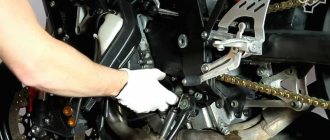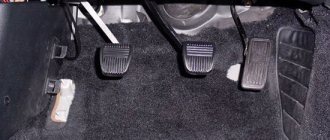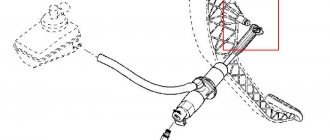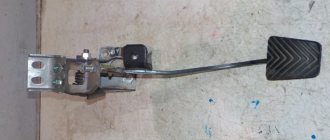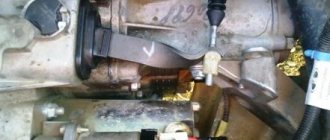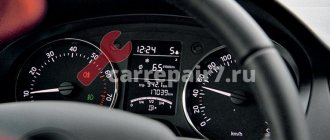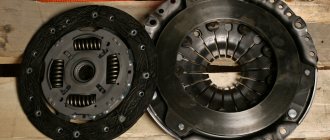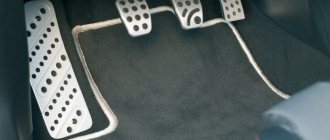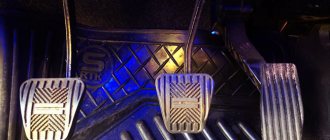The clutch is one of the most loaded mechanisms, designed to connect the gearbox input shaft to the flywheel of the internal combustion engine crankshaft. The clutch is engaged and disengaged by means of the clutch pedal, which can be “connected” to the release bearing mechanically or hydraulically.
One of the common malfunctions on cars with manual transmission is a stiff clutch pedal, when the driver needs to apply noticeable force when pressing. In this case, there may be several reasons why the clutch is tight: fastening of the pedal itself, problems with the clutch drive, malfunctions of the clutch mechanism, etc. Next, we'll look at the signs that indicate a hard clutch pedal is a symptom of a problem, as well as the causes of a tight clutch.
Clutch design and types: drive connection features
Before moving on to problems and a tight pedal, you need to pay special attention to the clutch design. A standard clutch installed on a vehicle with a manual transmission includes:
- drive disk;
- clutch driven disc;
- release bearing;
- release clutch and clutch fork;
- clutch drive;
- clutch basket.
There are several types of clutch:
- single-disk, double-disk or multi-disk (according to the number of slave disks);
- dry or wet (type of working environment);
- with mechanical or hydraulic drive.
On cars with manual transmission, the most common type today is a single-plate dry clutch with a hydraulic or mechanical drive. The connection methods for the clutch pedal may also differ.
The mechanical method of connecting the pedal to the release bearing is through a cable connected to the clutch fork, which mechanically presses the release bearing, which opens the clutch discs.
In the case of the hydraulic method, the pressure of the release bearing is controlled by liquid. In this case, when you press the clutch pedal, excess pressure is created in the hydraulic circuit, which, in turn, acts on the hydraulic part of the release bearing, which opens the clutch discs.
Correct operation of the clutch should be accompanied by clear engagement and disengagement of gears when the clutch pedal is depressed. The transmission of torque from the internal combustion engine to the gearbox should be smooth, without breaks in traction or extraneous noise. The pedal operation itself should be smooth, moderately light, without noticeable vibrations.
It is also necessary to emphasize that a correctly adjusted clutch pedal (if adjustments are provided on a specific model) must have free play.
How the clutch works (briefly)
The clutch is controlled by a pedal located inside the car. Connection to the plug is made using a cable located in a protective casing. Let's imagine that the gearbox lever is set in the neutral position, and after the engine starts, the crankshaft begins to rotate. The basket presses the disc tightly against the flywheel. By pressing the pedal, we release the mechanism and torque is not transmitted from the engine to the gearbox; at this time, we engage first gear if we need to get underway, and smoothly release the clutch. The disk again begins to press against the flywheel, transferring torque from the engine to the gearbox and the car moves off.
If the force from the engine is suddenly transferred to the gearbox, the car will stall due to the load. The smooth operation of the mechanism allows you to extend the life of components.
Signs of a bad clutch
Clutch problems can affect the overall technical condition of the car and affect the safety of both the vehicle itself and other road users.
Symptoms of malfunctions:
- the appearance of uncharacteristic sounds when pressing the clutch pedal;
- uneven pedal pressure;
- the need for frequent adjustments to the free play of the clutch pedal;
- intermittent engagement of the clutch when releasing the clutch pedal;
- clutch slipping (the appearance of a burning smell from the friction linings of the driven disc, increased fuel consumption).
We also recommend reading the article about why the clutch pedal has become soft. From this article you will learn why the clutch pedal is soft, as well as what to do in this case.
If the clutch pedal is mechanically driven, then the reasons are as follows:
- malfunctions in the clutch pedal mounting mechanism;
- failure of the mechanical clutch engagement drive;
- deformation of the clutch fork;
- failure of the release bearing;
- failure of fork mounting bushings;
- wear or deformation of the clutch spring petals;
- jamming or jamming of the cable in the braid.
Hard hydraulic clutch pedal, reasons:
- fluid leakage from the hydraulic circuit or presence of air in the system;
- failure of the release bearing guide;
- failure of the hydraulic piston of the release bearing;
- malfunction of the clutch basket (deformation or wear of the spring);
- failure of the working cylinder (damage to the cuffs).
Adjustment process
How to adjust the clutch on a VAZ 2114? The process occurs according to the following points:
- We install the vehicle at the work site. It is not necessary to use a room with a pit or an overpass, since the work is carried out in the engine compartment of the car, and it can be done on a regular flat area.
- To gain access to the cable connection point, you must remove the air filter housing.
- The process of adjusting the clutch pedal begins with measuring the pedal travel distance. It is necessary to take measurements several times with high precision down to millimeters.
- The ideal values for the VAZ 2114 would be 12.5 -13.5 mm . In other cases, the cable needs to be adjusted. Turning it counterclockwise will lower the pedal closer to the floor; turning it clockwise will raise it.
- We carry out the procedure until we achieve a result that falls within the norm of indicators. After that, tighten the nuts and squeeze the clutch a few more times to make sure the tightening is correct.
The video demonstrates clutch adjustment on a VAZ 2114:
While performing work, inspect the condition of the cable for breaks, corrosion or fractures. If there are such defects, it is better to immediately replace it with a new one.
After assembly and completion of all work, you should check the operation of the mechanism in motion. A good indicator of a correctly adjusted clutch will be activation already in the middle of squeezing, that is, 6-7 cm of the pedal from the floor.
Troubleshooting the clutch drive
As a rule, when one of the signs of a clutch drive malfunction appears, it is necessary to accurately determine the malfunction. If the problem is in the clutch mechanism, it is better to change the entire clutch kit, and not limit yourself to just the part that has failed.
It is also necessary to take into account the high cost of repair work, since it is often necessary to remove not only the clutch itself, but also the gearbox.
Methods for eliminating some clutch faults:
- a malfunction of the clutch release clutch bearing is eliminated by lubricating or replacing the bearing;
- problems with the hydraulic drive require replacing the fluid and bleeding the clutch;
- wear or contamination of the driven disc linings, wear or weakening of the pressure springs is eliminated by adjusting the pedal free play, as well as by replacing the driven disc pads or deformed springs.
We also recommend reading the article on how to adjust the clutch pedal. This article will teach you when to adjust your clutch and how to adjust your clutch pedal.
If problems with operation and a tight clutch pedal remain after repair, we can identify a number of other reasons why the clutch is tight. Among them are:
- clutch cable wear;
- dirt, corrosion in the cable jacket;
- lack of lubrication on the clutch fork shaft.
If we are talking about a hydraulic clutch drive, then the reasons may be a malfunction of the clutch master or slave cylinders.
Let us also add that it is important to replace the clutch release fork as a complete set with the clutch assembly when it becomes deformed or worn out. If this is not done, the plug may burst or bend during operation.
